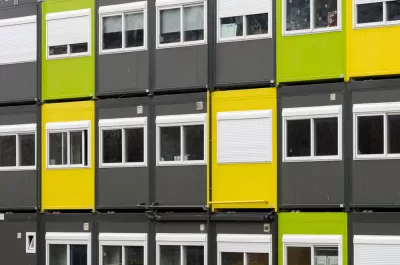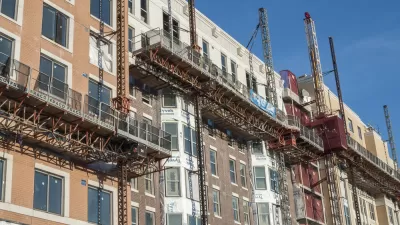To improve housing costs and economic conditions at once, look to the locations of modular housing factories.

Affordable housing developers are keenly aware of the growing need to house struggling residents quickly. The pandemic has only exacerbated the mismatch between housing supply and housing need. There is, of course, also an economic crisis, and affordable housing development is a proven strategy to spur job creation and spark positive ripple effects across multiple sectors.
However, operational challenges precipitated by the pandemic—not to mention the strain on public resources‚ have made affordable housing developers extremely sensitive to the costs of building new developments. This has increased the appeal of modular housing construction, which has been promoted as a way to boost productivity, cut costs, and force innovation in traditional construction. Modular homes are residences built to near completion in factory environments, and later transported in sections to construction sites.
However, that potential has not yet been realized, and one of the reasons is the expense and delay that comes from shipping the modular parts in from distant factories. If components of a modular home are built at a local factory situated nearer the construction site, developers have the convenience of both logistical and cost efficiencies, cutting down project time and contributing to a smaller carbon footprint.
A strategy that would address housing supply, construction cost, job creation—and even the jobs-housing mismatch—would be to locate more modular housing factories directly in regions with high housing costs, in parts of those regions that suffer from lack of jobs and long commutes to what jobs there are. Developers seek certainty in the building environment, and a robust set of local fabrication facilities could bring efficiency, reliability, and timely delivery.
Take Southern California, for example. The Southern California Association of Governments (SCAG), the metropolitan planning organization for the region, has been told by the state housing department that the region will need ...
FULL STORY: Build Modular Housing Factories Near Areas with High Housing Costs

Study: Maui’s Plan to Convert Vacation Rentals to Long-Term Housing Could Cause Nearly $1 Billion Economic Loss
The plan would reduce visitor accommodation by 25,% resulting in 1,900 jobs lost.

North Texas Transit Leaders Tout Benefits of TOD for Growing Region
At a summit focused on transit-oriented development, policymakers discussed how North Texas’ expanded light rail system can serve as a tool for economic growth.

Why Should We Subsidize Public Transportation?
Many public transit agencies face financial stress due to rising costs, declining fare revenue, and declining subsidies. Transit advocates must provide a strong business case for increasing public transit funding.

How to Make US Trains Faster
Changes to boarding platforms and a switch to electric trains could improve U.S. passenger rail service without the added cost of high-speed rail.

Columbia’s Revitalized ‘Loop’ Is a Hub for Local Entrepreneurs
A focus on small businesses is helping a commercial corridor in Columbia, Missouri thrive.

Invasive Insect Threatens Minnesota’s Ash Forests
The Emerald Ash Borer is a rapidly spreading invasive pest threatening Minnesota’s ash trees, and homeowners are encouraged to plant diverse replacement species, avoid moving ash firewood, and monitor for signs of infestation.
Urban Design for Planners 1: Software Tools
This six-course series explores essential urban design concepts using open source software and equips planners with the tools they need to participate fully in the urban design process.
Planning for Universal Design
Learn the tools for implementing Universal Design in planning regulations.
City of Santa Clarita
Ascent Environmental
Institute for Housing and Urban Development Studies (IHS)
City of Grandview
Harvard GSD Executive Education
Toledo-Lucas County Plan Commissions
Salt Lake City
NYU Wagner Graduate School of Public Service





























